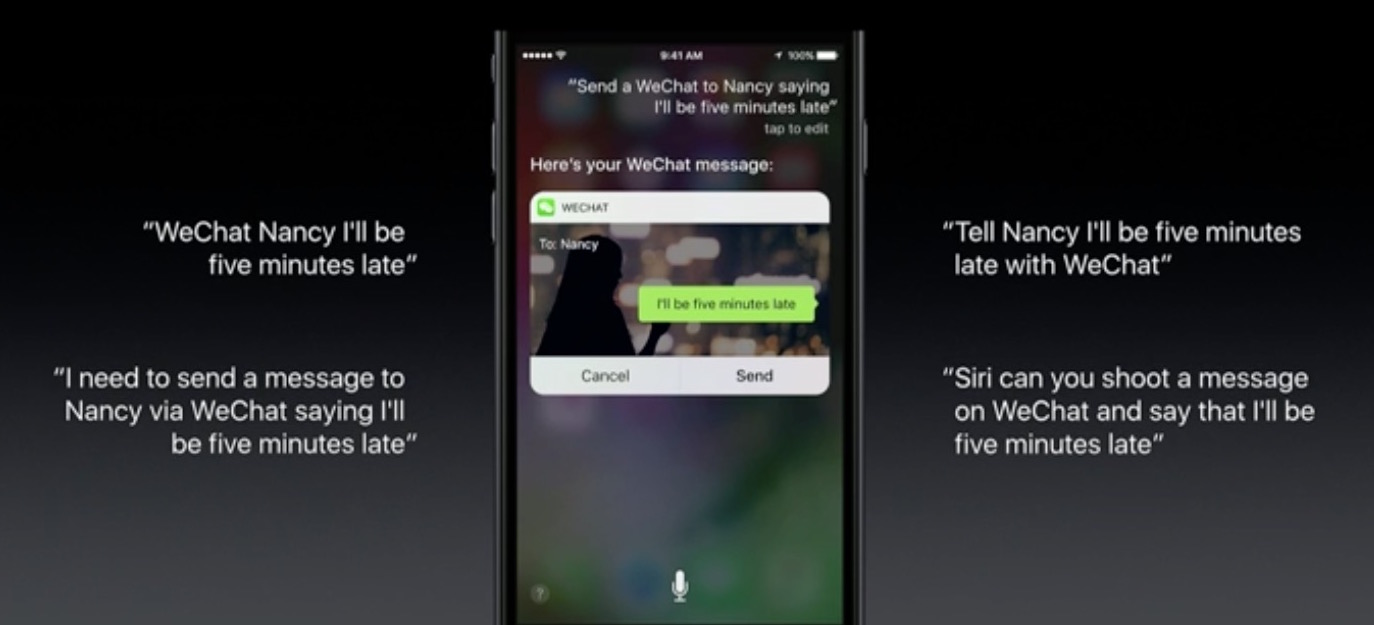The Apple community is still abuzz about WWDC 2016’s plethora of announcements. As a mobile app development company, only two questions matter to our developers and designers: “how can this Apple improvement positively affect our clients?” and “how can these advancements help me do my job better?”

After sitting down with our iOS developers and UX/UI designers, here are some of the key takeaways from WWDC 2016 that will provide product owners and managers with opportunities to create a frictionless user experience and interface, attain stricter security measures and provide more accessibility options for all types of users within their apps. This piece should spark new perspectives for developers around the world about how they can improve their apps/clients’ apps!
Enhancing User Experience with Siri Integration
As mentioned in Apple’s keynote announcements last Monday, Siri will now be fully integrated with certain categories of third-party applications. Instead of jumping from app to app with a rigid user experience, Siri will combine a number of categories together into one experience. Apple is expanding on its previous Siri-integrated capability with the HomeKit.
The categories announced so far include:
- Payments
- Ride sharing
- Maps
- Messaging
How will it work? A user simply holds down the home button and commands Siri to perform an action. For example, to order an Uber ride, a user won’t have to open the app, enter the pickup and drop-off location, choose a car, accept the surge or request a ride. A user simply asks Siri to order a ride and verbally commands all of the previously-mentioned steps. An Uber interface will pop up without changing apps and show that a ride has been requested. Siri’s new capabilities allow the user to access a third-party app without changing their current screen whether that be the home screen or inside another app. Siri is also expanding its vocabulary by learning and understanding different phrases.
Here is an example from WWDC 2016 keynote announcement with the app WeChat:

For product owners, this is incredibly exciting. Apps will be more accessible and easier to use with one simple verbal command. Apple logic suggests as users become more acclimated to asking Siri to accomplish certain tasks, infrequently used apps will be used more often. The tech giant will announce more categories for Siri integration in the future, which will cast a wider net for these apps. As additional categories are announced, product teams will need to re-strategize how their apps can optimize this Siri function and make their app experience so seamless that users can’t live without it.
“The more visible and effortless Apple can make the interface, the happier the customer is,” said Matt Michelson, UI/UX designer at stable|kernel.
Our clients in the retail and banking industries will greatly benefit from this Siri integration, especially when more categories are announced down the road.
A Focus on User Privacy and Security
Another primary focus at WWDC 2016 was user privacy and security. With countless attacks on user’s private information every day, Apple has made it a priority to ensure all user information is safe within their apps. Some of these focal points include:
- Designing a new file system for use on all devices – with built-in support for encryptionCurrently, iOS has full encryption capabilities. Following this announcement, macOS will have full encryption or encryption per file. This allows for profile encryption where the entire hard drive will be encrypted as well as individual files. This new feature will protect all users’ information more securely.
- App Transport Security RequirementApp transport security is a function that requires your app to use HTTPS instead of HTTP when it sends messages back and forth to the web server. It will be useful for end users because it ensures that when potentially private information is sent to a server, the end user can be assured that this information is encrypted. The main benefit is to guarantee users are protected by building apps to support HTTPS. Apple will no longer provide support for using HTTP.
- Ability to have copied text on the clipboard expireCurrently in iOS, when text is copied to the clipboard, it’s available to all apps on the iPhone until something else is copied. With the new iOS 10, users have the option to expire the text, keeping information private. For example, when a user copies an interesting link, it will save on the clipboard. Hours later, the user opens their Facebook app which recognizes there is copied information on the clipboard and then tries to encourage users to post a status including the copied text. The clipboard expiration is another way to ensure users’ information is protected.
A Stronger Emphasis on App Accessibility

This year, Apple put a stronger emphasis on developers to incorporate accessibility features into their apps and offered numerous sessions on this topic. The more developers incorporate these accessibility features into their apps, the more apps will be used and enjoyed by a wider array of people. This is really important for product owners to make sure their apps utilize all of the available technologies to guarantee accessibility to all users.
One of the existing accessibility features that Apple spotlighted is dynamic type. Dynamic type allows users to specify their preferred text size in their device’s settings. Additionally, Apple introduced the accessibility inspector – this feature checks an app and confirms if the app is 100% accessible for all users. Apple also announced multiple new accessibility features for mac OS, tvOS, watchOS and iOS 10.
One of the more interesting opportunities to learn about accessibility at WWDC 2016 was a lunchtime session hosted by Haben Girma, the only deaf and blind student ever to graduate from Harvard Law School. Apple wanted attending developers to gain insight into what it’s like to be a user with disabilities. stable|kernel iOS engineer Sean Swezey attended the conference and thoroughly enjoyed this unique session.
“Haben was an inspiring speaker,” Swezey said. “After listening to her talk about how she uses accessibility features on her phone to communicate, it helped me realize that an app must be designed and written from the beginning with accessibility in mind. It is just as important as the colors, fonts, and layout of the app.”
Whether applying Siri integration, enhancing security and privacy within apps or improving accessibility, our developers and designers here at stable|kernel are excited to incorporate these new or advanced features into our development process. Each year, we come away from WWDC excited to apply new features and technologies to our work. It’s inspiring to see how Apple is thinking about inclusiveness for all users, something we look forward to helping our clients achieve.
